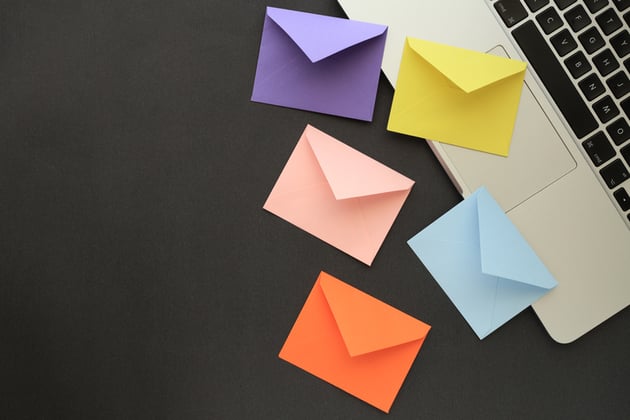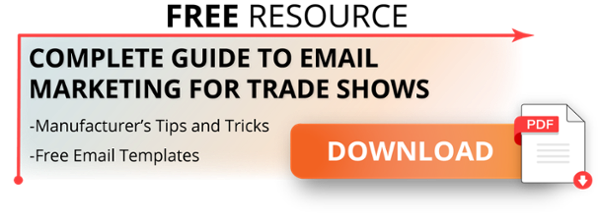Inbound Marketing Blog
for Manufacturers and Healthcare Companies
Guide to Follow-Up Email Marketing [TEMPLATE + EXAMPLES]

What happens when you collect a shiny, new lead?
Sadly, many B2B marketers and sellers either neglect it (by forgetting to feed or nurture it) or kill it (by overfeeding it with junk).
Failure to follow up with the contacts you earn from trade shows and website lead-capture forms is a waste of marketing and sales dollars. On the other side of the same coin, pushy and pitch-y correspondence is … also a waste of marketing and sales dollars.
Follow-up email marketing is awesome for building brand awareness and nurturing leads not quite ready to buy. Best of all, it can be quick and effective -- and even automated.
Below we’ll share best practices for sales and marketing email follow-up, then provide you usable templates for initial, middle, and final touchpoints.
Best Practices for Follow-Up Email Marketing
In addition to the issues above, part of the problem with today’s follow-up touchpoints is that sellers and marketers simply don’t know what to say in them. So they either trot out their basic sales pitch or send nothing at all out of fear of seeming pushy.
Here’s a quick rundown of the “when,” “what,” and “how manys” of following up with a lead:
When Should You Use Follow-Up Emails?
Email marketing follow-up sequences, or even a single follow-up note, can supplement many B2B sales and marketing tactics and targets:
- When someone signs up for an offer (i.e. e-book, whitepaper)
- After a sales conversation
- Leads collected from trade shows
- Anyone who signs up for an event (i.e. conference)
Deploy them whenever you have a specific goal in mind for a contact or set of contacts. That could be nurturing a sales lead, reminding readers about your upcoming webinar, or offering a free consultation.
How Many Follow-Up Emails Should You Send? How Often?
Never get trigger-happy with sending marketing or sales follow-up emails -- you’ll look desperate. One exception is when the recipient just signed up to receive something (i.e. a free checklist), and you want to provide the download link. (Indeed, the almighty “Here’s your link” email is an awesome excuse to send a quick follow-up with bonus resources.)
If it's a trade show list you’re targeting, give attendees a few days to get back in their offices and catch up before reaching out. For lead-magnet downloaders, other than that first “Here’s your link” email, wait several days between touchpoints. You don’t want to come across as pushy -- many B2B buyers take months or even years to make a purchasing decision.
As for how many? The example below uses a three-touchpoint process, but there are plenty of marketers who send 5+ emails spread out over several weeks.
Any touchpoint should start with a reminder about your last email -- don’t assume they opened your last email or read whatever material they asked you for initially. From there, the length of your follow-up sequence will depend on your campaign. Just make sure you can take a hint when someone’s not into you -- sending 4-5 spammy emails per week for a month will raise your unsubscribe rates and lower your open rates.
How to Approach Leads
Your tone will vary somewhat depending on how far along the lead is in their B2B buyer’s journey. However, one belief should permeate all your sales and marketing emails -- replace that old “always be selling” mindset with “always be helping.”
Never send an email -- or do any marketing/sales activity -- without providing value to the reader. Simply saying “let’s do business” isn’t enough -- especially if they’re still early in a long B2B sales cycle. Instead, soothe a pain point or open an opportunity by offering:
- Educational articles
- Free downloadables (i.e. research studies, e-books)
- Discounts on events (i.e. webinars, conferences)
- Case studies
- Personalized videos
Keep the tone somewhat informal. In the case of a sales call or trade show follow-up, perhaps you can lead with a personalized tidbit (i.e. a comment on their hometown baseball team’s performance last night). If you don’t know their interests off-hand, dig them up on social media. Just use good judgment so you don’t cross the line from “looks prepared and did research” to “comes across like a serial stalker.”
Follow-Up Email Marketing Strategy Template
Maybe you’re doing just fine with your lead-generation efforts ... but do you have a plan in place for these leads?
Below is an example of an email marketing follow-up sequence for leads who just downloaded an educational e-book on CNC machining design. The goal is to show how marketing/sales emails can nudge prospects further down the funnel.
Note that these emails are sent by an actual person with an actual face. (You’ll replace the stick figure with your own mug.) We strongly encourage you to use a real person for the sender’s name, “from” address, and signature rather than “sales@yourcompany.com.” This transparency makes your email look more human and personalized.
(p80 Tip: Working on trade show email marketing? We have a set of dedicated email templates just for you. Click the graphic below.)
Follow-Up Email #1: Linking & Thanking (Immediately After Requesting Download)
Subject Line: “Thanks a bunch!”
“Hi [recipient’s first name],
Congratulations on leveling up your component design!
We hope you enjoy the Engineer’s Handbook to CNC Machining Design. If you lost your download link, here it is again:
[Your Link Here]
Since designing for [recipient’s industry] includes so many cost and compliance considerations, I thought you could use these additional free resources:
- CNC Machining vs. 3D Printing for High-Volume Jobs
- 5 Ways to Reduce Machining Secondary Operations (& Cost)
- How Your Machining Supplier Can Help You Meet ISO Standards
If you have questions on anything in the e-book or the other resources, don’t hesitate to ask.
Cheers,

- [Your name]
- [Your company]
- [Your website]
- [Your phone number]”
Follow-Up Email #2: Offering More Resources (3-7 Days After Email #1)
Subject line: “About your CNC design resources”
“Hi [recipient’s first name],
Hope you’re enjoying your Engineer’s Handbook to CNC Machining Design. For engineers looking to further optimize their project (and get the boss’s approval), often the next step is to balance that next-level design with cost efficiency.
This additional resource -- Guide to Precision Manufacturing Costs -- reveals how to streamline your budget through:
- Material changes
- Design changes
- Process changes
- Vendor change
[Your Link Here]
Hope this helps!
Thanks,

- [Your name]
- [Your company]
- [Your website]
- [Your phone number]”
Follow-Up Email #3: Final Check-In (1 Week After Email #2)
Subject line: “Where could your project be optimized?”
“Hi [recipient’s first name],
It’s been a while since you downloaded the Engineer’s Handbook to CNC Machining Design. Has the way you think about your component’s design evolved since then?
If you’re still struggling to optimize your component’s performance or price point -- or evaluating whether precision machining is the right process for your project -- we can help. Simply schedule a free engineering consultation here:
[Your Link Here]
We specialize in helping [recipient’s industry] companies streamline cost and performance, so don’t hesitate to reach out if you need an outside expert opinion.
Best of luck!

- [Your name]
- [Your company]
- [Your website]
- [Your phone number]”
What About Breakup Emails?
In the lead-capture follow-up example above, it’s probably OK to leave things alone after the third email. But what if you’re following up with a sales-qualified lead who’s suddenly gone MIA? Or what if you’re trying to clean out marketing-qualified leads from an overcluttered CRM?
This is one example of when a formal “breakup email” may be worthwhile. The purpose of these emails is to see whether a contact wants to continue a relationship with your brand. These last-ditch efforts are invaluable, no matter the recipient’s answer to your request for a sign of life:
- If “no,” or they don’t respond: You’ve got one less bad-fit lead wasting space in your CRM, and you can improve your email metrics.
- If “yes”: You’ve pulled a Frankenstein and revived a once-dead lead!
Example Breakup Email
Subject line ideas: “This is my final email” | “Before I go … another free resource” | “Can I close your file?”
“Hi [recipient’s first name here],
In the past several weeks, I’ve reached out a few times to see whether [your product or service] might help with your [customer’s pain point]. I’m assuming there’s been a shift in your priorities since then, so I won’t be reaching out again after today. Here’s one more resource I find useful for [customer’s pain point], just in case you still need it.
Are you still interested in talking about your issues with [customer’s pain point]?
Sincerely,

- [Your name]
- [Your company]
- [Your website]
- [Your phone number]”
Automated Email Follow-Up
According to a Mailchimp survey of information workers, 59% said they could save at least 6 hours a week if the repetitive aspects of their job were automated.
With the right platform (we use HubSpot automation software, for example), you can set those repetitive follow-up emails to go out automatically. This is called an email workflow, or sequence.
What additional impact could your sales team make if it could focus on in-depth customer-relationship building rather than:
- Crafting the same email over and over?
- Manually compiling send lists?
Automation gets more done, period.
Pre- and Post-Event Marketing
Email marketing is as alive as ever. You just need to approach it in a much more customer-friendly way than our marketing forefathers did. Too much or too little, and you’ll kill the sale.
Use automated follow-ups to nurture leads and keep your brand top-of-mind. In the case of B2B trade show marketing, make sure you’re also nurturing existing leads before the show too.
To learn more about trade show-specific marketing tactics that work whether your events are in-person or remote, check out the free guide below:
Our Blogs, Direct to Your Inbox!
How to Audit your Online Marketing
If you are executing digital marketing, congratulations! You are most likely already one step ahead of your competition, and making strides to meaningfully connect with prospects online. But, how do you know if you’re seeing continual success year over year, and improving your metrics?
Without the tools in place to analyze and benchmark your efforts, it is impossible to scale your online marketing and ensure continuous success.



